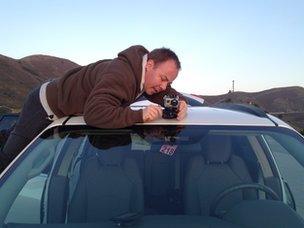Cameras to capture a road trip
- Published
- comments
Timelapse footage of journey from San Francisco to Las Vegas
Driving from San Francisco to Las Vegas seemed a good idea when we planned it a couple of months ago. We could visit some of the software giants of Silicon Valley, then head to Vegas in time for the opening of the Consumer Electronics Show.
And our visit to the Valley proved fruitful. At the Google campus in Mountain View I was struck again by how much the place resembles a very well endowed university, with brilliant young people from around the world strolling with their laptops talking about big ideas, between grazing on the free food and playing the odd game of ping pong.
At Facebook's sprawling new headquarters in Menlo Park, Mark Zuckerberg ambled past showing some guests round his new home, leaving us scrambling unsuccessfully for our cameras.
And we dropped in on top technology blogger Robert Scoble, and marvelled at his bedroom studio which features the kind of gadgetry which would make anyone even a little geeky green with envy.
But then we had to get in the car and start driving, while making the journey look interesting for a programme we are planning, a long and dull route to Bakersfield and then on across the desert to Las Vegas didn't seem too promising.
Luckily I had with me two camera nuts, who'd brought enough equipment to shoot an episode of Top Gear. I'm travelling relatively light this year - just three phones, a laptop, some radio equipment and a couple of tablet computers. (That includes a Kindle Fire I've bought here - a third the price of an iPad - and, so far, quite impressive.)
But cameraman Steve Adrain had his main broadcast Sony PMW 350, a Canon EOS 7D Digital SLR, and a lipstick camera which he fixed to various parts of the car to get a different angle.

Jonathan Sumberg with his GoPro
And producer Jonathan Sumberg, who also doubles up as a cameraman, had with him a Sony EX1 - a smaller broadcast-quality camera - and two GoPros. These tiny and relatively cheap devices have revolutionised the filming of action sequences - you just clamp them to a bike, a car, or even a surfboard, press the button and hope you capture something exciting.
So we set off down the long straight road across California and Nevada with two GoPros fixed outside the car, and the Canon Digital SLR fixed to the dashboard. Earlier, Steve had used the DSLR with a fish-eye lens to get some extraordinary video footage crossing the Golden Gate Bridge.
Now he set it to take a still every six seconds as the sun set over the freeway south. He left it on a fixed aperture, so that as the light faded, the exposure got ever longer. Jonathan and I got rather impatient with the constant clicking for four hours, especially when it continued through our rest-stop at a fast food outlet. But I think you will agree that the resulting time-lapse sequence is pretty stunning.
It set us talking about what has happened to camera technology in recent years. You can now capture HD video on a whole range of devices - from top end broadcast cameras through Digital SLRs right down to smartphones. And the gap in image quality between a £10,000 camera and a £250 one has got a lot smaller.
Now we have arrived at Las Vegas, where lots of new cameras will be unveiled at this week's Consumer Electronics Show. There is already a debate about which camera formats will survive, with one respected blogger predicting that the DSLR will die, external, made obsolete by lighter cameras with interchangeable lenses but no mechanical mirror inside.
That post provoked an angry backlash from SLR fans who believe you can't beat a viewfinder that gives you exactly what your lens is seeing.
What is clear is that the price of capturing high quality images continues to fall. The half dozen cameras we have brought here probably cost less in total than the bulky kit we would have used a decade ago. And, with luck and a bit of hard work from Steve and Jonathan, the pictures should be better.